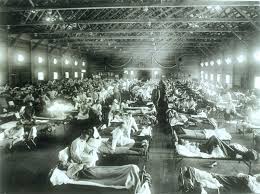Jaya Patel
The Massacre of 1918
February 23, 2015
In 1918, a perpetuator of mass genocide quietly rose to fame over the course of two months. This particular killer was formulated in a hero’s camp, born to betray the human race and become a dictator of fear. Today we know this killer as Spanish Influenza, which eventually killed between 20 million and 50 million people worldwide, including over 600,000 Americans. This pandemic will be the deadliest disease that ever happened in the United States, and have an extremely significant impact on the world. The treatments, causes, impacts, and deaths are very important on their own, but they have an even greater impact when they are banded together.
For treatments of the 1918 flu, infected people would often seek the local physician or nurse for herbal and medicinal “cures”. While there was no definite cure for the Spanish Flu, homemade remedies were used to alleviate symptoms and isolate the diseased persons. Once the flu became more prominent, scientists and researchers mistakenly addressed the sickness was caused by a bacteria, not a virus. This confusion was eventually realized, and the proper treatment of the virus ensued shortly after. Most doctors were stumped with diagnosing the flu, as the symptoms are very similar to that of the common cold, especially when a new strain of the virus emerged in late 1918. The symptoms of the new virus included a fever of 102-104 degrees Fahrenheit, along with bloodshot eyes, a scratchy throat, coughing, nose bleeds, and exhaustion, but in more severe cases diarrhea and vomiting were also present. Local herbs were sometimes used in the hope of dulling these symptoms, but they were only of little help in combating the flu.
The cause and origin of the Spanish Flu is still somewhat up for debate. In early March of 1918, reports from Kansas began to flow into the world of Public Health officials, and by May of 1918, Europe was reporting cases of the similar disease that was infecting young soldiers. Most of the soldiers recovered, until a second, more deadly, form of the disease began to spread around the world. Many doctors speculate that the virus originated in America, while others believe it grew in China and Europe, and this debate still continues today. On the official CDC website, it explains that most flu pandemics before and after 1918 originated and developed in Asia. With this information that explains most of the pandemic’s origins, some scientists still speculate on whether it started in Europe or even North America.
The 1918 Spanish Flu pandemic was one of the most significant in human history. An estimated 500 million people worldwide were infected with the flu and over 25% of Americans eventually were infected. The virus was first documented in Europe but quickly and efficiently spread to Asia and America in a matter of months. People were urged to take precautions and wear face masks to help prevent the spread of this contagion, but sometimes this did not help, as the virus mutated into pneumonia and quickly ended in death. In 1918 the average lifespan of an American dropped by 12 years due to the likeliness of contracting the virus and succumbing to the flu.
The deaths of the Spanish Flu totaled around 50 million around the world, but many estimates run as high as 100 million, but it is nearly impossible to get an exact number of how many people died from the flu. President Woodrow Wilson even contracted the virus in 1919 while writing the Treaty of Versailles, proving that no one was immune to the disease. Some precautions used in the hope of lessening the effects of the flu included; opening businesses only for small windows of time, wearing medical masks, and installing shutters on windows and doors to “keep the flu out”. Most of these precautions worked to no avail, but the effects of the flu finally fizzled out in late 1919, because most people either died from it or developed an immunity to the virus. Recently scientists were able to determine what exactly made the Spanish Flu so deadly- 3 genes were determined that weakened the immune system and made a path for pneumonia. 
The Pandemic of 1918 still continues to be one of the worst, and deadliest, pandemics in history around the world. With little knowledge, medical research, and sanitation, there was a perfect breeding ground for the virus to grow with power. In recent times, the flu has made many comebacks, but none as significant as the Spanish Flu, but if it ever did we would be armed and ready.
This is cool. It's interesting that they have difficulty pinpointing the cause. The drop in lifespan for Americans during that time was interesting as well. What is the difference between a pandemic and an epidemic?
ReplyDeleteThis is cool. It's interesting that they have difficulty pinpointing the cause. The drop in lifespan for Americans during that time was interesting as well. What is the difference between a pandemic and an epidemic?
ReplyDeletea. i didnt know that the flu is such a dangerous virus. this will make consider getting a flu shot in the future.
ReplyDeleteb. i am curious about why this virus is so deadly.
c. what makes the flu so deadly?
1) It is interesting that there were multiple waves that came through areas all affecting people differently
ReplyDelete2) i am confused about the how it was mistaken as a bacteria not a virus
3) were people ever not diagnosed that had the virus?
1. I just think it is so weird and interesting to think that the flu could be so deadly to people.
ReplyDelete2. It kind of confuses me that doctors would say it was a virus and not a bacteria.
3. Did the doctors have some way of protecting themselves from the disease when checking on their patients?